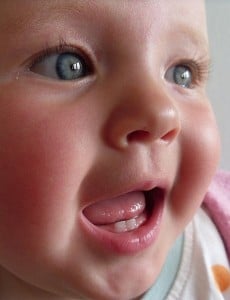 Teething is a very exciting development in a baby’s growth. With this new addition to their experience, it is important to stay on top of their dental hygiene in order to promote good oral health right from the start.
Teething is a very exciting development in a baby’s growth. With this new addition to their experience, it is important to stay on top of their dental hygiene in order to promote good oral health right from the start.
As your baby’s teeth start to come in, you can start cleaning them with a toothbrush. Try to find a brush that has very soft bristles and a small head; there are many specially designed toothbrushes for babies on the market. Just wetting the toothbrush with water and gently brushing each of your baby’s teeth will be sufficient. After about one year of age, you can start using non-fluoridated toothpaste; you don’t want to use toothpaste with fluoride in it until your baby is.
Brush your child’s teeth at least twice a day. Make sure that you cover all surfaces of the tooth to remove all the plaque that’s accumulated over it. Brush the inside, the outside, and the sides of each tooth if you can; if bacteria can reach it, you need to, too. If you can manage it, try brushing your baby’s tongue as well though, this task may prove difficult with an understandably uncooperative child.
Once the toothbrush’s bristles look worn out and start losing their orderly appearance, it’s time to change toothbrushes. Using an old toothbrush results in ineffective and inefficient cleaning.
It is not necessary to floss your baby’s teeth, but it is an option for further cleaning when your baby’s teeth begin to touch each other and you can no longer reach the sides with a toothbrush.
If you have any questions or concerns regarding your child’s teeth or notice anything that you think may be unusual, please contact us at the Lakeway Center for Cosmetic and Family Dentistry so that we can answer your questions and help you in any way that we can.
